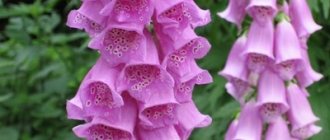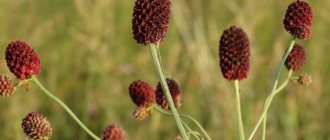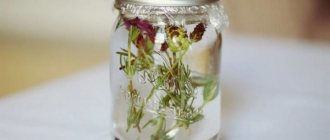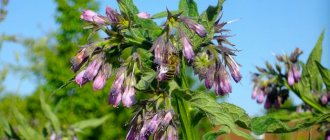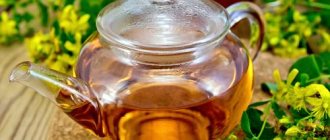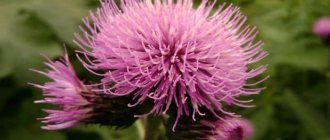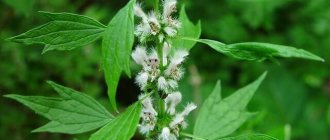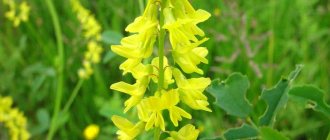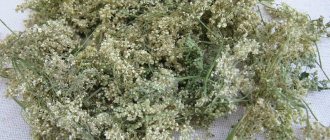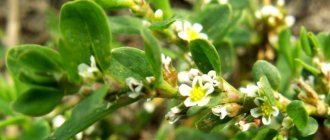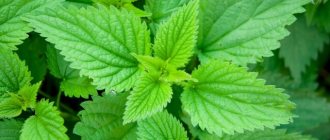Aconitum L., (1753)
Aconite (fighter) is an extremely poisonous plant and should be used with great caution. You can find aconite bushes in damp nooks and crannies of our forests, next to rivers and swamps, in damp meadows near bushes. The wrestler reaches a height of up to 1 m, almost completely covered with palmately dissected dark green leaves. The flowers are blue, arranged on a long raceme.
Some gardeners transplant aconite from the forest to their flower beds; there are also large-flowered garden forms of aconite, however, they all cause poisoning in both people and animals. The alkaloid, which is part of all parts of the plant, has a paralyzing effect on the respiratory center, and eating it by domestic animals often leads to their death.
The petals of the aconite flower form the shape of a shoe into which bees and bumblebees crawl entirely. The insects apparently like aconite pollen, but the nectar still causes bee poisoning, so they collect it only in the absence of other honey plants. Under the ground, on the roots of aconite, tubers are formed that are even more poisonous than the plant itself.
Description of aconite
Aconite (also known as wolfsbane, blue buttercup) is a perennial, tall shrub. Belongs to the ranunculaceae family. There is a legend that the plant grew at the site of the death of the hellish dog Cerberus. In Scandinavian mythology, aconite appeared at the site of the death of the god Thor. The plant is poisonous. Its venom was used to poison opponents, in hunting predators, and for medicinal purposes.
Aconite contains alkaloids that cause paralysis of the nervous system, convulsions, difficulty breathing and vomiting. At the same time, the toxicity of the shrub depends on the place of its growth. The most poisonous plants are common in southern latitudes. In areas with cool climates, aconite is harmless. Some types of aconite are included in the Red Book.
There are about 300 species of aconite. Distributed in Asia, Europe and North America. The rhizome is tuberous, the stem is mostly erect, occasionally curved in some species. The height of the bushes, depending on the type, is from 50 to 150 centimeters. Aconite begins to bloom in summer and until mid-autumn. In terms of color, aconite most often comes in blue and purple tones; pink, white, yellow and purple shades are also found.
Aconite tubers smell like horseradish and look like celery. Consumption of aconite roots is very dangerous for the body!
For what diseases is aconite used?
All types of wrestler contain potent poisonous alkaloids. In ancient times, due to its poisonous properties, aconite was often used to prepare poisons. Later, aconite found use in folk medicine as an external pain reliever for neuralgia, joint pain, rheumatism, and colds.
Chekanovsky's aconite is used in traditional medicine in the treatment of acute and chronic inflammatory diseases, epilepsy, toothache, and cancer.
In Russian folk medicine, aconite is known as an external pain reliever. Antidote aconite, as it is less poisonous, is taken orally for the treatment of malaria, paralysis, migraines, lower back pain, for worms, and also as an antipyretic and antidote for poisoning.
In China, aconite is popular as an ingredient in anti-cancer and other remedies.
Planting aconite
Aconite is quite unpretentious and any cultivated soil is suitable for planting it. The only thing aconite requires is good drainage. The plant does not like abundant moisture and stagnant water. During prolonged rains, care should be taken to ensure that the soil under the aconite bushes is not dammed. Waterlogged soil can lead to the death of the plant. Aconite can be planted under the crowns of trees, because he is not afraid of the shadow.
Contraindications
Djungarian aconite is contraindicated for children, people with low blood pressure, pregnant and lactating women.
After external use of aconite tincture, you should thoroughly wash the container under the product and your hands with soap, avoid getting the tincture in your eyes, because it can blind a person.
In case of aconite poisoning, you must immediately take a vomiting agent, constantly drink a decoction of oak bark, or black coffee, or just warm water. Microenemas with hemp, linseed or olive oil and mustard applications on the legs and arms are effective for poisoning.
Fertilizer and feeding of aconite
Aconite can grow in one place for a long time, so the soil under it will deplete over time. To maintain nutritious soil, mineral fertilizers should be added to the soil. Aconite also responds well to organic fertilizers. In the spring, before flowering begins, add a small amount of compost to each bush. It is enough to feed aconite once a season. As a result of proper feeding, the bushes will be rewarded with juicy and bright flowering. It would be a good idea to mulch the soil.
Collection, preparation and storage of plants
All parts of aconite are used as medicinal raw materials. The grass is harvested before flowering, the roots are harvested in October. To avoid poisoning from the essential oils of the plant, work is carried out in the morning, before the heat sets in. The youngest roots are left to regenerate the thickets; the very old ones are thrown away. The rest are peeled from the side roots, washed and dried in one layer in a well-ventilated area.
All actions with raw materials are carried out by the wrestler wearing gloves; during work, touching the face and eyes is not allowed. Volatile compounds in the plant can also have a toxic effect, so the time spent in the room where wolf root is dried should not exceed 1.5-2 hours. Store dried raw materials in linen bags marked: “Poisonous!”
All parts of aconite are used as medicinal raw materials.
Propagation by seeds
Propagating aconite by seeds is the most labor-intensive method. It is necessary to carry out stratification. Stratification is the creation of conditions of different temperatures and humidity levels to stimulate seeds. Before winter, the seeds are sown in a container with soil and placed in a fairly cool place - a refrigerator, cellar or balcony.
In mid-spring, the container is transferred to a warm place for germination. After the first shoots germinate and the first two leaves form on them, the seedlings can be pruned. Aconite sprouts can be transplanted to a permanent place in the garden or flower bed in August. The distance between plants is about 25 cm. After about two or three seasons, aconite will bloom.
How to use
Aconite root (fighter) is used in folk medicine for cancer. Aconite was first used as a medicinal plant in Tibet. It was used to treat various tumors and infectious diseases. In Ancient Rome, aconite was grown for decorative purposes, but due to its high toxicity and many accidents, its cultivation was abandoned.
Today, Djungarian wrestler is used mainly in alternative medicine. Based on the roots and leaves of the plant, products are made for the treatment of neurological diseases and oncology. In homeopathy, aconite is used to treat migraines and headaches.
For household purposes, Djungarian aconite is used as an insecticide against cockroaches and flies. In agricultural production, aconite must be completely destroyed due to its high degree of toxicity to livestock and honey bees.
For medicinal purposes, root tubers and leaves of aconite are used as an antispasmodic, local irritant and antibacterial agent. Aconite is also used in the treatment of late-stage cancer. For the preparation of medicines, raw materials are used in fresh or dried form.
For cancer
Treatment of cancer with potent poisons is practiced in late stages, when official medicine has not brought results. It is important to remember that the use of Djungarian aconite is unacceptable without the consent of the attending physician.
Aconite is used for any type of oncology, including bone cancer. It is believed that the plant's poison suppresses the growth of cancer cells and blocks the development of metastases. Take tincture of Djungarian aconite according to a certain scheme. The poison of aconite has a cumulative effect. When treating cancer, the dosage of the tincture is gradually increased. Small doses trigger the body’s protective properties, and it begins to fight not only intoxication, but also tumors.
Tincture for cancer
Ingredients:
- Chopped dried aconite tubers - 1 tsp.
- Edible alcohol.
How to prepare: Dilute food grade alcohol with clean water to 40 degrees. Pour 500 ml of diluted alcohol over the dried aconite. Let the product brew for 2 weeks in a cool, dark place. Shake the tincture periodically. After the expiration date, strain it through a gauze napkin.
How to take: Start taking the tincture 1 drop 2 times a day. Before taking, dilute the tincture in a small amount of drinking water. The next day, increase the dose by 1 drop. Bring your daily intake to 10 drops per day. Continue taking 10 drops for 10 days. Then start taking the tincture in the reverse way, reducing the dose by 1 drop daily. Take a break for 1 month. Carry out 7 courses of treatment according to this scheme.
For pain
Aconite tincture is also used for various types of pain: toothache, migraine, rheumatism, radiculitis and neuralgia.
Tincture for pain
Ingredients:
- Crushed dried aconite tubers - 20 g.
- Edible alcohol.
How to prepare: Pour aconite with alcohol (500 ml), diluted to 35-40 degrees. Let the product brew for 1 week in a cool, dark place. Shake the tincture periodically. After the expiration date, strain it through a gauze napkin.
How to take: For rheumatism and radiculitis, rub a small amount of the product into the sore spot and wrap it with a cotton bandage, and then with a warm down scarf.
For neuralgia and frequent migraines, take the tincture orally for 1 month. Start with 1 tsp. per day and gradually increase the dosage to 1 tbsp. in a day.
For toothaches, rub 1 drop of tincture into the gums or apply to a sore tooth. You can also rub a small amount of the product into the cheek on the side of the diseased tooth.
For wounds
To treat purulent, difficult-to-heal wounds and boils, a decoction of aconite tubers is prepared.
Decoction for wounds
Ingredients:
- Crushed dried aconite tubers - 20 g.
- Pure water - 250 ml.
How to prepare: Boil water. Pour boiling water over the dried tubers. Place the broth over low heat and boil the aconite tubers for 20 minutes. Cool and strain the broth through a gauze cloth.
How to take: Gently wash the area of inflammation with the resulting decoction. Carry out the procedure up to 3 times a day.
You will learn more about the use of Djungarian aconite in the following video:
Symptoms of aconite alkaloid poisoning
The clinical picture of aconite poisoning appears within a couple of hours after the toxin enters the human body. First, a person experiences symptoms of excitement, which are abruptly replaced by depression of consciousness. Symptoms of poisoning are:
- Strong excited state;
- Copious secretion of saliva;
- Fear of light and spatial orientation disorder;
- Tingling and itching of the skin;
- Redness of the skin, appearance of pinpoint rashes on the body;
- Loss of sensitivity, pale skin and blue discoloration;
- Disturbance of the gastrointestinal tract - burning, pain, heaviness in the esophagus and stomach, vomiting, diarrhea;
- Pain in the heart area;
- Arrhythmia, characterized by periodic fading of pulsation;
- Breathing problems.
Against the background of the symptoms that appear, the victim develops a fear of death and difficulty urinating. In some cases, there is a complete absence of urination. Disruption of the heart and nervous system leads to human death.
Can poison be medicine?
When a substance enters the body, it affects not only healthy cells, but also cancer cells. The therapeutic effect of aconite is based on the fact that after absorption of the active substance, doctors can control the treatment process. Since the poison first blocks the functioning of the affected cells, under the supervision of specialists it is possible to prevent the penetration of large amounts of poison into healthy tissues.
Precautionary measures
Djungarian fighter is a poisonous plant. Please observe the following precautions when using it:
- When collecting and preparing aconite, use disposable gloves.
- Do not touch open areas of skin and mucous membranes with your hands when preparing and using raw materials for medicinal purposes.
- When drying root tubers in the oven, cover a baking sheet with parchment paper, and after drying, wash it thoroughly with dishwashing detergent.
- After handling raw materials, wash your hands thoroughly with soap and running water.
- Store finished medicinal raw materials separately from any food and medicinal products.
- Keep raw materials out of the reach of children and pets. Be sure to mark the container with raw materials with the label “Caution! I!"
- Do not exceed the permissible dosage of the drug.
- Before using alcohol tincture of aconite internally, be sure to dilute it in a small amount of drinking water to avoid poisoning.
- Before using Djungarian aconite, be sure to consult with your doctor.
- If you suddenly feel unwell after taking aconite, call a doctor immediately.
Application
Woolly aconite is effectively used to improve hearing and vision, for melanoma (malignant tumor), anemia, convulsions, pulmonary tuberculosis, goiter, diabetes, impotence, diphtheria, infectious diseases, anthrax, psoriasis, venereal diseases, erysipelas, leprosy, as a wound-healing agent . Useful for abscesses and old ulcers, loss of strength, urinary stones, bronchial asthma, jaundice.
Norms and doses: 1 teaspoon of crushed roots (tubers) of woolly aconite, pour 1/2 liter of vodka. Infuse the drug for two weeks in the dark, shaking daily. Tincture of woolly aconite is used in folk medicine to treat oncological diseases (cancer). Treatment can be carried out according to the method of Tishchenko V.V. “Tsarskaya” (see article Treatment of cancer with hemlock): start with 1 drop three times a day, increasing from 1 to 40, and then back, decreasing (80 days).
Attention! When preparing, storing and using woolly aconite, you should remember that it, like other types of aconite, is poisonous.
The Book of Health wishes you good health!
What is aconite, what does it look like
Aconite is the name given to any of hundreds of plants belonging to the genus Borets.
Wolfsbane is a showy herbaceous perennial with distinctive, upright growing stems, small, attractive flowers and palm-shaped leaves. It is because of the zygomorphic flowers that wolfsbane is unlike other members of the ranunculaceae family, to which it actually belongs. And it is very reminiscent of lupine (wolf bean), a common crop from the legume family. However, the inflorescence of the common lupine, consisting of blue or purple flowers, is more compact. Wolfsbane has two types of root systems:
- Tuberous roots, which over time form a whole system of 12–15 roots, stretched out in the form of a chain, or single tuber roots, which die off annually along with the above-ground part.
- A taproot consisting of many thin, cord-like, tightly intertwined roots.
The height of aconite can reach 1 m. Its leaves are very rich green, round in shape, palmate. The apical raceme consists of flowers with a five-leaf calyx, which can be yellow, blue, white or lilac. It begins to bloom in mid-July and ends in October. The fruits are dry leaflets.
Bees collect small amounts of nectar and pollen from aconite flowers. But only if there are no other flowering plants in the area. Aconites can cause poisoning in them.
Diseases and pests
Despite the toxicity of the fighter, it is often provoked by pests that cause aconite diseases. So, the flower is often affected by diseases such as:
- Powdery mildew - symptoms of the disease are light or grayish spots on the foliage. Under the influence of pathology, the bush quickly withers and dies. To eliminate the violation, the affected parts are cut off with a sharp knife, and the entire plant is treated with fungicidal agents.
- Ring mosaic - when affected by this pathology, the foliage becomes lethargic with the presence of yellow or brown spots on the surface. For treatment, the affected parts of the plant are removed, and the bush is treated with insecticides. It is important to prevent aphids from appearing on aconite, since they are carriers of ring mosaic.
- Viral greening is a pathology that causes deformation of the stems. The disease damages flowers, which change their shape. There is no solution to this problem. Therefore, to prevent the disease of other individuals in the flowerbed, aconite will have to be dug up.
In addition, aconite can be attacked by some pests that are not afraid of the poisonous properties of the fighter. Thus, the plant can be damaged by aphids, rapeseed flower beetle and nematodes. To solve the problem, the bushes are treated with insecticidal solutions. In addition, you can prevent the appearance of some pests by regularly loosening the soil.
Spreading
It grows naturally in the center of Europe and northern Asia. A prerequisite for the existence of aconite is a large amount of fertile soil, so most often the flower grows in meadows and highlands and along rivers. Certain varieties of aconite grow in North America.
In Russia, aconite is an ornamental plant that is grown only under cultivation conditions. However, the flower grows quickly, so if not properly cared for it can go wild. Wild plants in Russia are found on the sites of old houses, abandoned areas and along roads.
Consequences of poisoning
Intoxication with aconite alkaloids is accompanied by high mortality. The severity and outcome of poisoning depends on the amount of toxin entering the body, the timeliness of first aid and specialized treatment.
The lethal dose of pure aconite is 3–4 milligrams. The poison is very quickly absorbed through the skin and mucous membranes, enters the bloodstream and is utilized by tissues. Death occurs from cardiac arrest in the diastole (relaxation) phase.
The faster the victim is provided with emergency care and then taken to a hospital for detoxification and symptomatic therapy, the greater the likelihood of a favorable outcome. During recovery, asthenic syndrome persists for some time. As a rule, no other residual effects of poisoning are observed.
Aconite is a plant that has both medicinal and poisonous properties. These qualities are due to the toxic alkaloids included in its composition. The use of aconite in official medicine is currently limited to antiarrhythmic and analgesic therapy. However, the antimetastatic and antitumor effect of the plant remains outside the scope. Is it necessary to expand the boundaries of its application? - further scientific research will show. In the meantime, aconite is used only in Chinese medicine. Since the difference between the healing and toxic dose is very small, there is a high probability of poisoning. Therefore, self-medication with aconite is completely excluded. To carry out folk treatment with this plant, you should contact only long-time practitioners. In case of poisoning, the most important factor is time. Rapid provision of emergency and specialized medical care significantly improves the prognosis of recovery.
Applications of aconite
0
Types and varieties
The most popular among gardeners is aconite hood (the flower got its name due to the similarity of the shape of the flower with a monk’s hood - hood) or blue. This is a plant that grows up to 150 cm in height. It blooms with blue flowers from July until the end of summer. In addition to decorative use, it also has medicinal uses. The fighter of this species winters well without shelter in our latitudes. Due to the variety of forms of aconite capulaceae, many varieties of the plant have been developed. For example:
- Albiflorus is a plant with white flowers;
- Carneum - aconite with beige-pink flowers;
- Eleanor - a variety with white flowers with a red border;
Eleanor - Rubellum is a variety with pink flowering;
Rubellum - Nevri Blue is aconite with deep blue flowering.
- Monkshood bicolor is considered a variety of glomerulosa. The two-tone wrestler is distinguished by the color of the flower; it is white with a purple edging.
- Aconite is tall. Forms a bush, with a straight thick stem, up to 2 m high. The leaves and stem are pubescent. The flowers are purple, collected in large inflorescences - racemes. Summer flowering. The plant is adapted to the climate of the middle zone. An interesting variety for gardeners is the tall aconite variety - Ivorin, with cream flowers and a height of only 60 - 70 cm.
Other types of aconite may be of interest as an ornamental crop:
- Fischer's aconite (native: Far East, plant height up to 150 cm, blue and white flowers);
- aconite woolly (densely pubescent bush, up to 1 m high, large yellow flowers); Woollymouth
- wolfsbane (bush, 50 cm high, with light yellow flowers, summer flowering, lasting up to 50 days);
Wolf - Kuznetsov's aconite (bush 80 – 130 cm in height, with large bright blue flowers);
- Baikal aconite (the birthplace of the flower is Siberia and Mongolia, the wolfsbane grows up to a meter in height, blooms with purple flowers).
Climbing types of aconite: aconite climbing and aconite arcuate. You can appreciate the beauty of aconite by looking at a photo of a flower.
Possible difficulties during cultivation
With the wrong approach to plant care, gardeners may encounter problems such as:
- Lack of flowering - the cause of this condition is often an insufficient amount of water in the soil. In addition, the flower stops blooming if the soil contains few nutrients or air.
- Late flowering - the cause of this phenomenon is low air temperature or characteristics of the variety. In the first case, the solution to the problem comes with improved climatic conditions, in the second - the problem simply does not exist, these are the characteristics of the variety.
Growing a wrestler in a garden does not require special efforts or creation of conditions from the grower. However, any plant requires care, which determines the duration of flowering and the beauty of the shrub.
Medicinal properties and indications for use of the plant fighter
A decoction of the root of the wrestler is an effective painkiller that is used for headaches and toothaches, rheumatism, sciatica, gout, and neuralgia.
Homeopathic tinctures based on the plant have an anti-inflammatory effect and help reduce fever during colds.
Preparations containing aconite stimulate the cardiovascular system, improve blood circulation, lower blood pressure, and regulate breathing rate.
Alcohol tinctures and ointments based on wrestler are used for the speedy healing of wounds and ulcers, and the treatment of furunculosis.
We recommend reading: Description of blue agave with photos, medicinal properties
The plant extract is used in gynecology, as well as for:
- laryngitis;
- pharyngitis;
- measles;
- cystitis;
- scarlet fever;
- hypertension;
- cardiac neurosis;
- angina pectoris;
- arrhythmias;
- tachycardia;
- furunculosis.
In addition, aconite extract is used as part of complex therapy for a number of oncological pathologies. Indications for use of the plant for cancer:
- stomach tumors;
- pulmonary neoplasms;
- skin cancer;
- thyroid tumor;
- neoplasms in the spine;
- prostate cancer;
- cervical cancer.
Chemical composition
Currently, the chemical composition of Aconite has not been fully studied. It is known that all parts of the plant contain alkaloids associated with aconitic acid, among which aconitine predominates.
The tubers of the plant contain approximately 0.18-4% of the total alkaloids of the aconitine group:
- Aconitine;
- Hypoaconitine;
- Mesoaconitin;
- Sasaakonitine;
- Getaconitine;
- Benzoylaconine.
Other alkaloids found were:
- Sparteine;
- Napelline;
- Neopellin;
- Ephedrine.
In addition to alkaloids, Aconite tubers also contain:
- Transaconitic acid;
- Daucosterol;
- Mesoinosidol (0.05%);
- Benzoic, citric, fumaric acids;
- Significant amount of sugar (9%);
- Resins;
- Saponins;
- Coumarins (0.3%);
- Linoleic, oleic, stearic, palmitic and myristic acids;
- Flavones;
- Starch.
The stems and leaves of Aconite contain tannins, the alkaloid aconitine, inositol, various trace elements (more than 20 types), ascorbic acid, flavonoids and other biologically active compounds.
